In another part of my life, there’s a discussion going on about the merits of the (semi)professional Minolta Dynax cameras of the latest generations. I happen to have the Dynax 800si as well as the Dynax 7 here, so I thought I’d do a comparison to see where these two are different, and how that is relevant in daily use.
In order of appearance:
In 1997, Minolta introduced the Dynax 800si. While the si series did not include a professional model (that would have been a 900si), the 8* designation was reserved for cameras that were “half a step up” in the food chain from the 7*. The first generation of the Dynax family (the European name for all autofocus cameras) had the 7000 and the 9000, the second generation had the 7000i and the 8000i. The third generation had the 7xi and the 9xi, and the si generation had the 700si and the 800si. The 8’s were cameras that would share a platform, but had a few extra features.
The last of the serious 35mm (film) Dynaxes were just a single digit without any letters added to it. 1998 saw the introduction of the Dynax 9, which was a camera aimed at professional photographers.
And then, in 2000, the Dynax 7 hit the market.
Minolta had been one of the most innovative camera manufacturers since at least the second half of the sixties — more so than the Big Two (Canon and Nikon), and the Dynax 7 was their Last Stand before they were merged into Konica-Minolta and the bean counters entered the building. Every useful trick they could come up with was thrown into the mix, resulting in the most advanced 35mm camera ever made, and surpassing their flagship model, the Dynax 9, in terms of features.
This would have made it The Perfect 35mm camera, if it weren’t for a few nasty problems. It was a camera aimed at the enthusiast consumer, so it needed to be not too heavy and bulky. As a result, where the Dynax 9 would use lots of metal (a mixture of unaffordium and forged metal), the Dynax 7 contained quite a few plastic parts. The film door closed with a single plastic latch, which, if you smash it close rather than close it gently, was bound to break after a handful of years. Another problem that’s quite common was a plastic gear driving the aperture coupling in the body to break.
Normally, these would’ve been fairly easy repairs — if parts would still be available. But in 2005 or thereabouts, Sony acquired all Minolta’s assets. Unfortunately, they didn’t want to have anything to do with any prior models. I recently heard a rumour saying that loads of Dynax 7D (the digital version of the 7) were thrown into the shredder near the Antwerp harbour, to prevent them from ever being sold.
So… no, no parts are available anymore. If your Dynax breaks, you’ve got yourself a technologically advanced door stop.
But quite a few survived up to this day.
I have hands-on experience with both the 800si and the 7. I have never had a 9, so all I know about that is hearsay from people who do, and reading the manual (yes, I am one of the last 16 people in the world who reads manuals).
So, whenever I mention the Dynax 9 in this comparison (in italics) keep that in mind.
First, a disclaimer:
This comparison is based on my preferences, and the way I use a 35mm camera. I’m sure there will be many points I won’t touch upon, but I’m not a professional camera journalist.
I will mainly be comparing significant (to me) differences. For instance: viewfinders are of equal size and brightness, so I’ll leave that out. I will also not say anything about image quality — when it comes to image quality, a 35mm camera body is nothing more than a light-tight box that holds a film and allows you to use the lenses to project the image onto the film. Which, considering these are cameras that use Minolta optics, is excellent news.
Physical properties
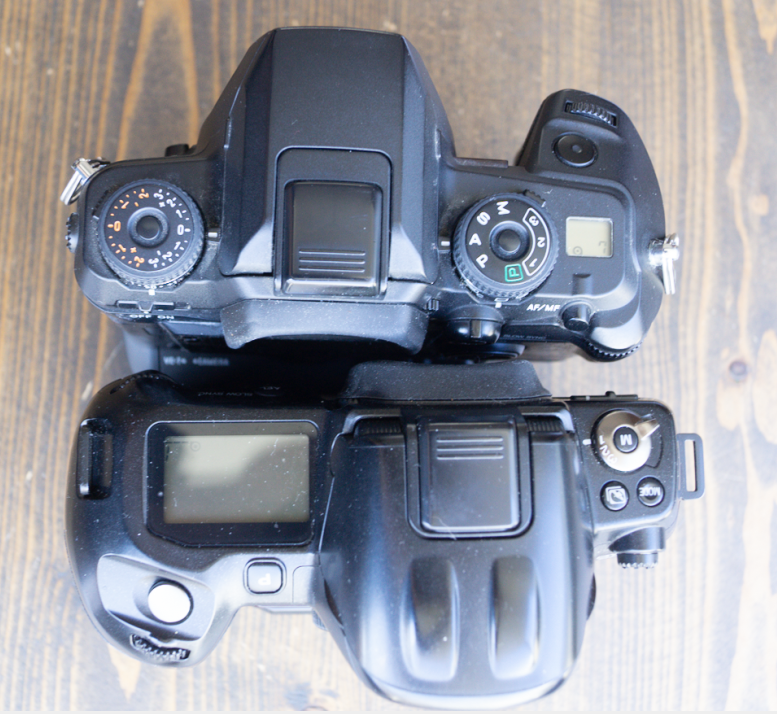
The 800si is noticeably bulkier – the right hand grip is thicker, which will probably feel a little bit better if you have bigger hands. That said, I have relatively small hands, and it felt … just right to me. The 7 leaves a bit more “space in the right hand”.
The vertical control grip of the 7 (VC-7) protrudes a little more to the rear, which add a little bit more confidence when held, but nothing drastic.
The 800si weighs in at 655 grams, the 7 is 45 grams less (both weighed with a film in their bellies). With their vertical control grips, it’s 996 grams for the 800si versus 978 grams for the 7 (with 4x AA in the grips to power the camera). All weights are body only.
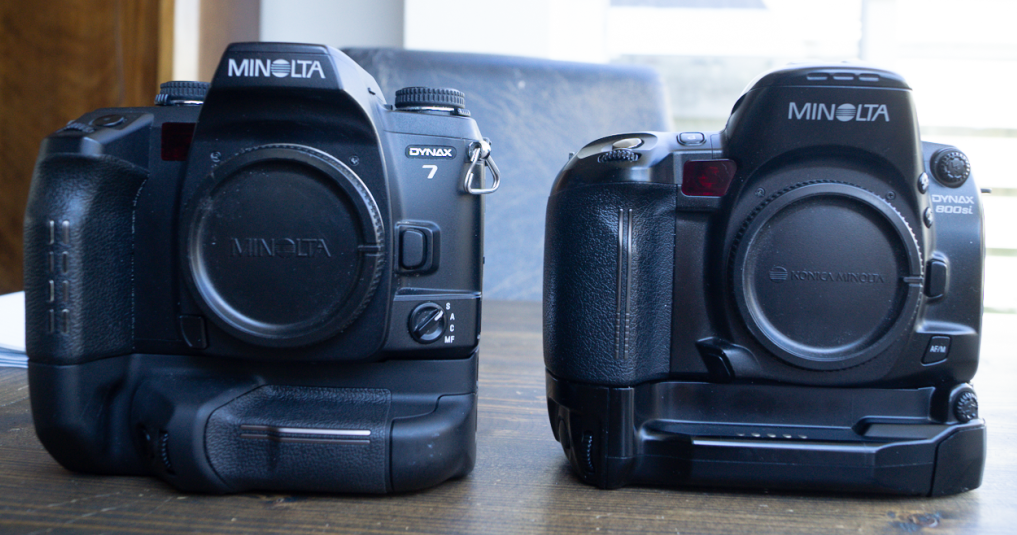
I use both cameras with their vertical grip (the VC-700 for the 800si and the VC7 for the 7 (I bet you saw that coming). The main reason for doing so is that the vertical grip allows you to run the camera on 4 AA batteries, rather than the rather exotic (as in, not available in every supermarket) batteries they use in a body-only configuration.
What’s in the viewfinder
Both cameras use the green line under the viewfinder image to display information, but there is one difference: the icon that displays the metering mode (center-weighted average, honeycomb pattern or spot metering).
But in the 800si, you can also see the metering mode (in normal light, that is), because a circle will appear in the AF area (the rectangle wherein the AF points are).
Camera LCD display
The LCD display of the Dynax 7 (on the back) shows a little more information than the 800si display (on the top, to the right of the prism: we can see how much exposure compensation we’ve dialed in, and in which drive mode the camera is, but that’s it. Also, the 7 will continuously show the battery condition, whereas the 800si will only (briefly) show it when it’s switched on.
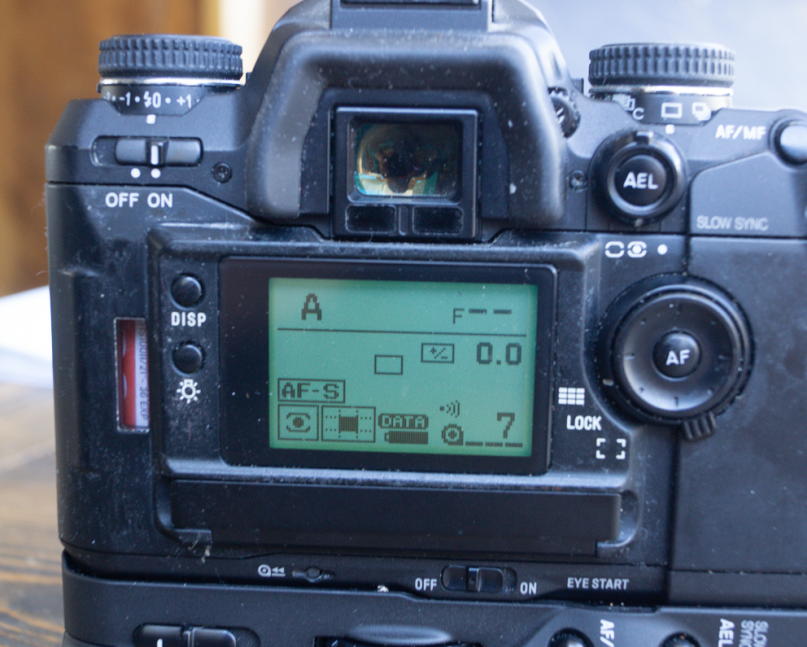
The 7 has a friendly button that will backlight the LCD display, thus not leaving you in the dark.
Focusing:
Both cameras have comparable autofocus speed under normal circumstances, but the Dynax 7 has more AF points (nine versus three), and being able to select the AF point by using the selector on the back makes life notably easier.
In low light, the Dynax 7 is noticeably quicker, but the difference is not staggering.
But the Dynax 7 takes a running jump ahead in terms of usability. You can actually see which AF point is being used, as the AF point chosen by the camera lights up, whereas the rectangle indicating the AF point used in the 800si is a thin black line, which is often invisible against a dark background.
The 7 allows you to select any of the 9 focus points and lock that. The 800si can only be configured to use the center AF point by using the AF button.
The Dynax 9 is, in terms of AF points and how to select them, up to par with the 800Si. Another user who has both tells me the Dynax 9 is slower to focus than the 7. The manual tells us that the Dynax 9 has “predictive autofocus, which supposedly enable sthe camera, based on prior movement, where the subject will be, allowing it to pre-focus on the correct position to prevent fast-moving subjects from being out of focus.
Metering:
The 7 (as well as the 9) lets you select the metering mode (center weighted/honeycomb/spot) through a dedicated dial on the back — versus behind a door and a menu cycle on the 800si.
Exposure compensation: this is set with a dial on the 7 and the 9, and with a button and menu cycle on the 800si.
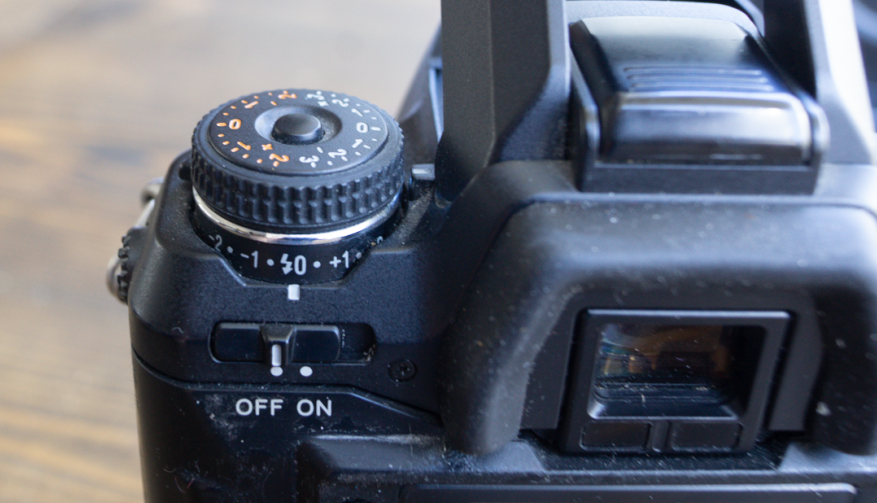
The meters agree 100%, by the way. Minolta sorted out their light meters to be frighteningly good centuries ago; no reason to change that.
Pop-up flash
Not even a contest. The 7 and the 9 have a normal pop-up flash like you’d expect on a camera, with a guide number up to 12. The 800si comes with a flash that is way more powerful – in fact, with a guide number of up to 20 it’s the most powerful popup flash on any camera ever. It’s big and scary and it has a zoom function if you use a lens that communicates distance information. Man, that thing sure knows how to light up a room. Nuke ‘em till they glow, boy!
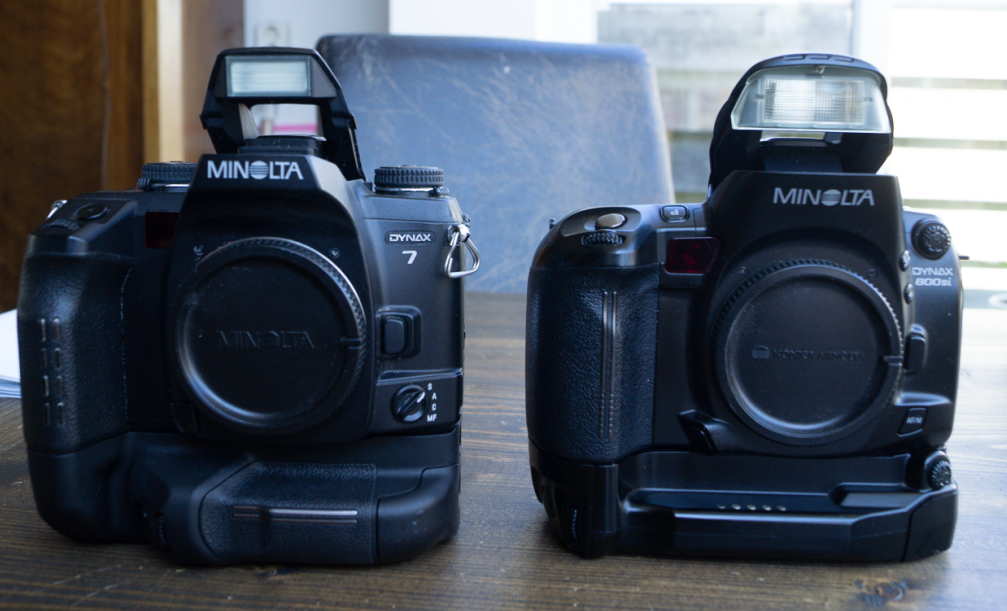
External flash
Both cameras support High-Speed Synch when used with the 5400HS, but only the 7 will support ADI flash with the 5600HS-D. Since I happen to have such a flash, I’m not likely to ever use the popup flash.
Since both my Sony digitals work juuust fine with the Minolta 5600HS-D, I have reason to assume that both cameras will work with the Sony 5600 flashes as if they were Minolta flashes – which they probably are.
Conclusion:
The 800si has stayed under the radar for me for a long time… mainly because it lacks direct (menuless) access to a couple functions that I find pretty essential, such as metering mode, auto exposure mode (PASM) and exposure compensation.
It does, however have one feature that greatly increases its usefulness, and that is that it has three configuration memory positions! This allows me to create a setting for automatic exposure with aperture priority, honeycomb pattern metering, AF-S, another setting for the same settings but with AF-C, and a third for manual exposure and spot metering.
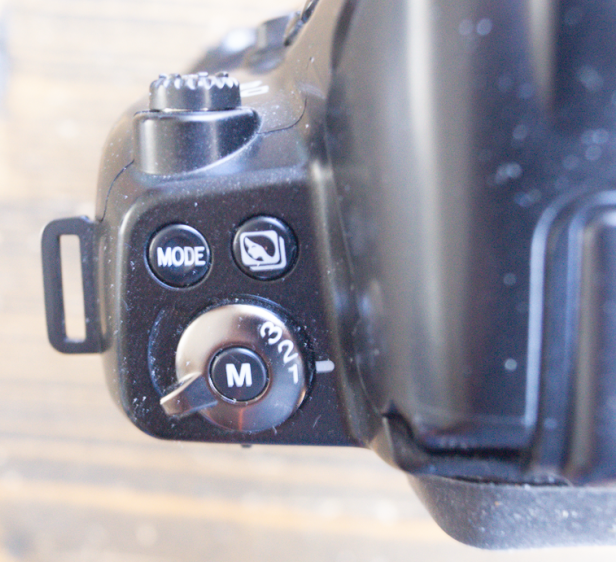
Being able to select the correct configuration memory position without using one of the scroll wheel covers 98% of my shooting needs. The 800si will require me to fumble a bit more, but I can live with that a *lot* better than with the arrangement on the 700si. So, while the 7 is staying (for as long as it stays functional), I’m keeping the 800si too. It has the Delta400 exposed at ISO800 in, and that’ll probably remain its main role. The 7 currently has an ADOX CHS100, but, what with it being better equipped for a more versatile role, it’ll probably get the ISO400 exposed as ISO320 or 250-role.
The Dynax 7 has a nasty reputation when it comes to reliability. I have two broken ones here to prove it, and I was pretty sure I wouldn’t try my luck on a third one.
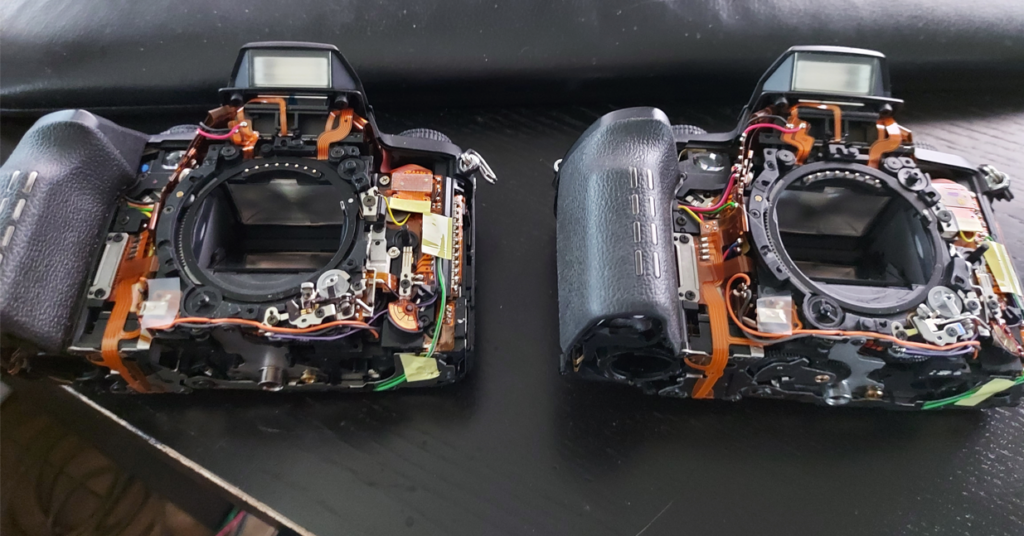
And yet, I did. I’m hoping this one will stay in one piece. Please, don’t die on me, sweet Seven.
Because when it works, it’s everything you could wish for in terms of useability. It is often called the most advanced 35mm film camera ever, and as far as I can see, that is entirely justified.
1 Pingback